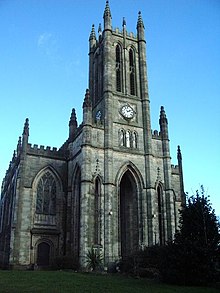| Church Building Act 1818 | |
|---|---|
| Act of Parliament | |
 | |
| Long title | An act for building and promoting the building of additional Churches in populous Parishes. |
| Citation | 58 Geo. 3. c. 45 |
| Dates | |
| Royal assent | 30 May 1818 |
| Commencement | 30 May 1818 |
| Repealed | 5 August 1873 |
| Other legislation | |
| Repealed by | |
Status: Repealed | |
| Church Building Act 1819 | |
|---|---|
| Act of Parliament | |
 | |
| Long title | An act to amend and render more effectual an Act passed in the last Session of Parliament, for building and promoting the building of additional Churches in populous Parishes. |
| Citation | 59 Geo. 3. c. 134 |
| Dates | |
| Royal assent | 13 July 1819 |
| Other legislation | |
| Amends | Church Building Act 1818 |
| Amended by | Statute Law Revision Act 1888 |
| Church Building Act 1822 | |
|---|---|
| Act of Parliament | |
 | |
| Long title | An Act to amend and render more effectual Two Acts, passed in the Fifty-eighth and Fifty-ninth Years of His late Majesty, for building and promoting the building of additional Churches in populous Parishes. |
| Citation | 3 Geo. 4. c. 72 |
| Dates | |
| Royal assent | 22 July 1822 |
| Commencement | 22 July 1822 |
| Other legislation | |
| Amends |
|
| Amended by | |
| Text of statute as originally enacted | |
| Church Building Act 1824 | |
|---|---|
| Act of Parliament | |
 | |
| Long title | An Act to make further provision, and to amend and render more effectual Three Acts passed in the Fifty-eighth and Fifty-ninth Years of His late Majesty, and in the Third Year of His present Majesty, for building and promoting the building of additional Churches in populous Parishes. |
| Citation | 5 Geo. 4. c. 103 |
| Dates | |
| Royal assent | 24 June 1824 |
| Commencement | 24 June 1824 |
| Other legislation | |
| Amended by | Statute Law Revision Act 1873 |
Status: Partially repealed | |



A Commissioners' church, also known as a Waterloo church and Million Act church, is an Anglican church in England or Wales built with money voted by Parliament as a result of the Church Building Act 1818 (58 Geo. 3. c. 45) and the Church Building Act 1824 (5 Geo. 4. c. 103). The 1818 act supplied a grant of money and established the Church Building Commission to direct its use, and in 1824 made a further grant of money. In addition to paying for the building of churches, the Commission had powers to divide and subdivide parishes, and to provide endowments. The Commission continued to function as a separate body until the end of 1856, when it was absorbed into the Ecclesiastical Commission. In some cases the Commissioners provided the full cost of the new church; in other cases they provided a partial grant and the balance was raised locally. In total 612 new churches were provided, mainly in expanding industrial towns and cities.